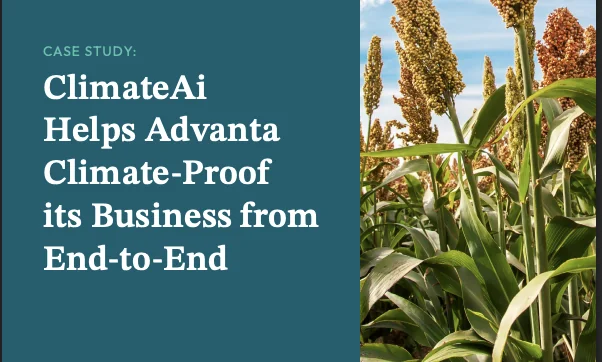Andy Paterson • September 18th, 2025.
Climate change is already impacting companies across sectors and geographies with droughts, floods, heatwaves, and extreme weather events.
To mitigate their risks and capitalize on climate-related opportunities, companies should develop effective adaptation strategies.
AI is emerging as a powerful tool to accelerate solutions and has already demonstrated success as a critical component in building adaptation strategies. In this article, we’ll explore five climate adaptation examples where AI is already making a difference across the agricultural value chain, for investors, and in global supply chains.
Challenge:
Agriculture and sectors across the agricultural value chain are some of the most impacted by climate change. The food and beverage sector, for example, is expected to lose up to 10% of EBITDA by 2050 without any additional adaptation.
An increasingly volatile climate will reduce yields for producers, increase prices, and minimize supply for buyers and consumers. Existing weather warning systems lack the accuracy and granularity for these stakeholders to base decisions on.
AI Solution:
Advanced weather intelligence models can make highly localized, accurate predictions that act as an early warning system for both short-term and long-term weather disruptions. Allowing growers to:
And allowing buyers to:
Climate Adaptation Example:

Advanta Seeds, an Australian seed company, used ClimateAi’s ClimateLens platform to anticipate climate-driven risks across its supply chain. Seasonal forecasts warned of wet harvest conditions, enabling the company to harvest early and avoid millions in potential losses. Predictive modeling also flagged an unexpected precipitation event two months earlier than other tools, allowing Advanta to secure and transport seed before competitors. This faster time-to-market increased sales by between 5% and 10%.
Challenge:
Climate change is increasing temperatures, droughts, floods, and saltwater intrusion. These new conditions necessitate the development of new types of seeds, tools, and techniques.
Research and development are typically a time-consuming and costly process that requires lengthy testing and management of large datasets.
AI role:
Some studies suggest that AI can double the speed of R&D. Here are three ways AI can accelerate the R&D process:
Climate Adaptation Example:
ClimateAi enabled a multinational agri-business to model current and future climate risks across key production regions and crops, showing that tomato yields in India could drop ~30% and that Italian leek production would remain viable. By surfacing these insights up front, the company avoided years of costly field trials, accelerated the launch of new crop varieties, improved margins, and built a more precise roadmap for long-term investment.
Challenge:
Increasingly common and more severe extreme weather events are having a significant impact on companies’ operations and global supply chains. In 2022, Texas winter storm Uri caused more than $100 billion in damages and lost business. The companies that had effective adaptation plans and were prepared for the storm were able to recover quickly and gain market share compared to their competitors.
There are numerous other examples of hurricanes, typhoons, and floods having the same impact, where some companies that were prepared won more business, and others lost out during the recovery phase.
AI role:
Modern AI weather models can predict weather conditions well in advance, often before traditional forecasting tools, providing companies with more lead time to prepare and adapt.
AI models can also be used with other data, like transaction data, to determine which companies perform better during disaster recovery, so that different companies can learn from top performers.
Climate Adaptation Example:
A roofing manufacturer was able to ramp up production and meet demand faster than competitors after ClimateAi helped them predict elevated hurricane risks in Florida ahead of Hurricane Ian. Ultimately, this led to them capturing an additional $15 million in sales in the recovery phase, as they had more shingles in place than competitors.
Challenge:
Interpreting climate data to inform adaptation strategies is complex and typically requires the expertise of agronomists or other highly trained professionals. Even when organizations collect the right data, they often lack the expertise to turn it into actionable strategies.
AI role:
Adaptation agents make this expertise accessible by allowing non-experts to query climate risks directly, such as how upcoming weather may affect a harvest, and receive recommendations on par with those of agronomists. For experts like commodity investors or researchers, agents dramatically speed up time-to-insight by delivering targeted answers without the need to analyze raw data manually.
Climate Adaptation Example:
NEC and ClimateAi co-developed an AI-powered Adaptation Agent that modeled crop-specific climate risks and simulated the ROI of interventions for cocoa and rice in Africa. By integrating hyper-local climate, yield, and economic data, the tool identified adaptation measures that delivered up to 150% ROI for farmers. The tool enables funders and governments to direct resources toward the most impactful strategies for food security and returns.
Challenge:
Companies often struggle to translate complex climate data into clear, actionable strategies across crops and sourcing regions. While climate risks, such as droughts and erratic rainfall, regularly impact producers’ yields and the prices of suppliers, most organizations lack structured methods to operationalize resilience.
AI role:
Adaptation Playbooks, powered by AI, turn climate forecasts into practical production and sourcing guidance. They help organizations decide when to adjust planting, where to find new sources, and how to optimize resources, creating a repeatable framework for building resilience.
Climate Adaptation Example:
A ClimateAi customer used our adaptation playbooks to map climate risks across nine value chains and adjust production and sourcing strategies. By shifting planting dates and rebalancing sourcing, the company delivered ROI in the first year and helped potato producers in India avoid losses for three consecutive years.
These climate adaptation examples show that AI is already a critical tool helping organizations adapt to worsening climate volatility.
AI enables adaptation to be measured and acted upon at scale, giving businesses that start today the opportunity to prepare for short-term disruptions and build a competitive advantage over the longer term.
To get started now on AI-powered adaptation solutions, reach out for a demo.

Andy Paterson is a content creator and strategist at ClimateAi. Before joining the team, he was a content leader at various climate and sustainability start-ups and enterprises.
Andy has held writing, content strategy, and editing roles at BCG, Persefoni, and Good.Lab. He has helped build one of the industry’s most popular newsletters and regularly publishes environmental science articles with Research Publishing.